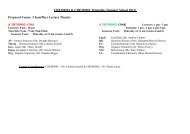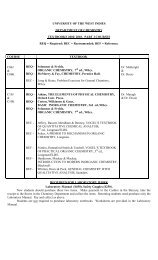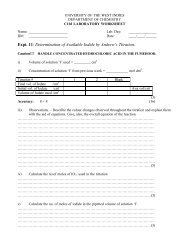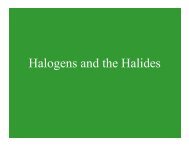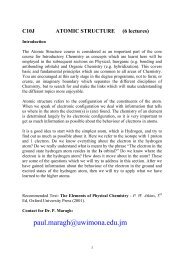faculty of pure and applied sciences - The Department of Chemistry ...
faculty of pure and applied sciences - The Department of Chemistry ...
faculty of pure and applied sciences - The Department of Chemistry ...
Create successful ePaper yourself
Turn your PDF publications into a flip-book with our unique Google optimized e-Paper software.
O-13 THE PERSISTENCE OF MIRAL 500CS ON TWO COFFEEFARMS IN JAMAICADwight E. Robinson<strong>Department</strong> <strong>of</strong> Life Sciences, MonaSerious outbreaks <strong>of</strong> the c<strong>of</strong>fee leaf miner (CLM), Perileucoptera c<strong>of</strong>feella, during 1991 - 1995prompted the spraying <strong>of</strong> several insecticides, particularly Miral 500CS (isaz<strong>of</strong>os), which wasfound to be quite effective in suppressing the CLM (Reid <strong>and</strong> Robinson, 1994). However, concernsabout its persistence in the environment <strong>and</strong> possible impact on non-target organisms prompted thefollowing study which was aimed at determining its persistence in two varied c<strong>of</strong>fee cultivatingconditions <strong>of</strong> Jamaica.<strong>The</strong> study was carried out on a Blue Mountain plantation (Mavis Bank) <strong>and</strong> another in the highl<strong>and</strong>s<strong>of</strong> St. Catherine (Mountain Hill). Sample plots <strong>of</strong> 0.2 ha with about 250 trees were selected on eachfarm <strong>and</strong> treated with Miral 500CS at a concentration <strong>of</strong> 3 mL/L. A 625 m 2 area <strong>of</strong> soil under treeswas demarcated in a separate area <strong>and</strong> treated similarly. Thirty leaves <strong>and</strong> berries were r<strong>and</strong>omlypicked from treated trees <strong>and</strong> a 100g sub-sample <strong>of</strong> soil taken from a mixture <strong>of</strong> ten 60-g soilsamples taken at r<strong>and</strong>om from the treated soil area. Samples were collected 2 hours <strong>and</strong> 1, 3, 7, 14<strong>and</strong> 21 days after treatment for extraction <strong>and</strong> analysis in the laboratory. Rainfall was also recorded.Samples were weighed, extracted in methylene chloride by shaking on a wrist action shaker, filtered<strong>and</strong> cleaned on a florisil column. Cleaned extracts were concentrated to 10 mL <strong>and</strong> analyzed on aShimadzu 9A gas chromatograph equipped with an FPD chromatopack data system. Analyticalconditions were: glass column, 1.6 m by 2 mm packed with OV-17; carrier gas; nitrogen, at a flowrate <strong>of</strong> 30 - 35 mL/min; temperature settings <strong>of</strong> 230 o C for the column <strong>and</strong> 260 o C for the injector <strong>and</strong>detector. <strong>The</strong> detection limit for isaz<strong>of</strong>os was 0.004 ng. Probit analysis was used to determine thehalf life <strong>of</strong> the insecticide on each substrate.<strong>The</strong> half life <strong>of</strong> Miral 500CS on c<strong>of</strong>fee leaves <strong>and</strong> in soil was 7-fold greater in the Blue Mountainthan highl<strong>and</strong> plantation (Table). This trend was reversed for the berries as the loss <strong>of</strong> Miral 500CSfrom the berries was 3-fold greater on the Blue Mountain than the highl<strong>and</strong> plantation. Variations inpersistence <strong>of</strong> the insecticide on leaves <strong>and</strong> berries <strong>of</strong> the plantations may be attributed to differingenvironmental conditions such as precipitation, temperature, sunlight <strong>and</strong> wind velocity, whichwould all impact on the insecticide’s loss <strong>and</strong> degradation (Edwards, 1975; Hill <strong>and</strong> Wright, 1978).In addition to these factors, its persistence in the soil would also be influenced by soil properties suchas the organic matter content.<strong>The</strong>re is a direct correlation between the persistence <strong>of</strong> insecticides in soil <strong>and</strong> organic matter content<strong>of</strong> the soil (Arnold <strong>and</strong> Briggs, 1990) which would explain the greater persistence <strong>of</strong> Miral 500CS inMavis Bank than Mountain Hill soil which had 4.55 <strong>and</strong> 1.15% organic matter, respectively. Itshould be noted that the half-lives presented were obtained under conditions <strong>of</strong> high rainfall (94 <strong>and</strong>128 mm in Mountain Hill <strong>and</strong> Mavis Bank, respectively) which is indicative <strong>of</strong> the highenvironmental persistence <strong>of</strong> Miral 500CS. It is, therefore, obvious that encapsulation <strong>of</strong> the activeingredient, in an attempt to reduce its hazardous effects, has resulted in its increased persistence inthe environment, thus prolonging possible harmful effects.35




